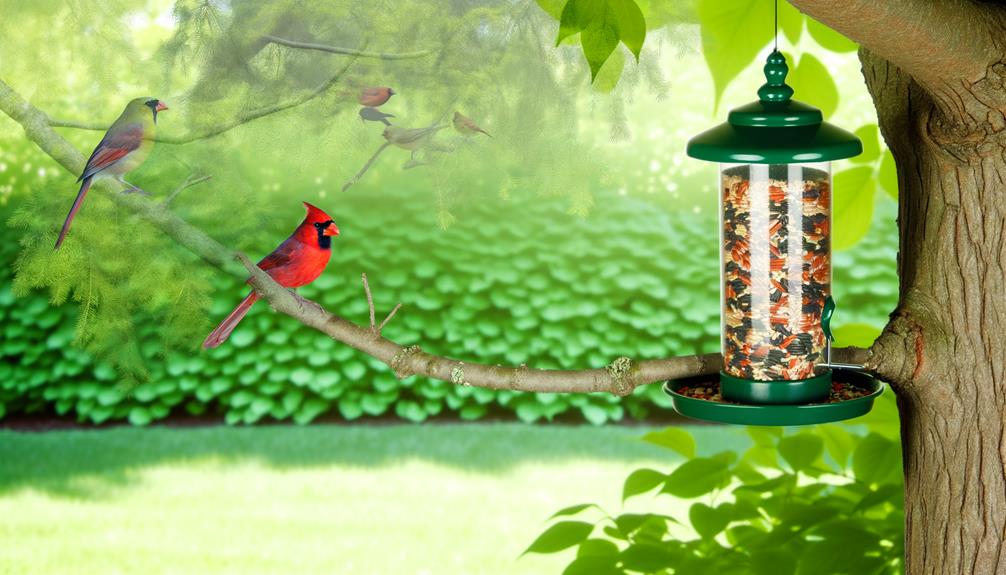10 Steps to Safely Catch a Cardinal Bird
Successfully capturing a cardinal bird requires a thorough understanding of their territorial behavior and habitat preferences, including dense, shrubby regions with tall trees and water sources. Place feeders at heights of 5 to 6 feet near dense foliage to attract cardinals, especially during peak activity periods.
Use lightweight, UV-resistant bird netting with a mesh size of 1.5 to 2 centimeters for efficient trapping. Regular monitoring and gentle handling procedures are essential to guarantee the bird's well-being.
Detailed tagging and data recording methods are vital for research integrity, and additional measures can provide more nuanced strategies and insights.

Key Takeaways
- Place feeders near dense shrubs or small trees at a height of 5-6 feet to attract cardinals.
- Offer a consistent supply of seeds, fruits, and insects to lure cardinals to your trapping area.
- Use bird netting with 1.5 to 2 cm mesh, ensuring it is durable, UV-resistant, and blends naturally with the surroundings.
- Monitor traps daily, check bait condition, and ensure trap functionality to increase chances of capturing a cardinal.
- Handle captured cardinals gently with a breathable cloth, ensuring not to compress their chest, for safe examination and tagging.
Understanding Cardinal Behavior
Cardinals, known scientifically as Cardinalis cardinalis, exhibit territorial behavior and a preference for dense, shrubby habitats. Understanding their ecological and behavioral patterns is essential for successful observation and capture.
These birds are highly territorial, often defending their chosen area aggressively, particularly during the breeding season. Their territories typically span about an acre, providing ample space for foraging and nesting.
Understanding their feeding habits is vital; cardinals primarily consume seeds, fruits, and insects, favoring sunflower seeds and safflower seeds. Vocal communication plays a pivotal role in their behavior, with males singing to establish territory and attract mates.
Observing these behaviors can provide valuable insights into their daily routines, aiding in the strategic planning required for their capture.
Choosing the Right Location
Selecting the best location for catching a cardinal bird necessitates an understanding of their ideal habitat. Cardinals are typically found in areas with dense shrubs and thickets, which provide both food and shelter.
Strategic feeder placement is also crucial. Placing feeders in these regions during peak activity periods, such as early morning and late afternoon, enhances the likelihood of successful capture.
Seasonal timing is another factor to consider when trying to attract cardinals.Understanding when they are most active can increase the chances of spotting and catching them.
Ideal Habitat Selection
To successfully attract and catch a cardinal bird, it is essential to understand and select a suitable habitat that meets their ecological preferences and requirements. Cardinals thrive in habitats that offer dense foliage, tall trees, and abundant food sources. They prefer areas with thickets, wooded edges, and gardens that provide ample cover and nesting sites. Ideal habitats also include water sources and diverse plant species for foraging.
| Habitat Feature | Description |
|---|---|
| Dense Foliage | Provides cover and nesting sites |
| Tall Trees | Essential for perching and roosting |
| Food Sources | Includes seeds, fruits, and insects |
| Water Sources | Necessary for hydration and bathing |
Selecting a location that integrates these elements will greatly increase the likelihood of attracting cardinal birds.
Feeder Placement Strategies
Best feeder placement requires a strategic understanding of cardinal behavior and environmental factors to secure maximum attraction and minimal disturbance. Cardinals prefer areas that provide both food and cover. Position feeders near dense shrubs or small trees, which offer refuge from predators and harsh weather.
Secure the feeder is at an ideal height of 5 to 6 feet, minimizing access for ground predators while remaining within easy reach for the birds. Avoid placing feeders in overly exposed areas to reduce stress and increase visitation frequency. Additionally, feeders should be kept at a reasonable distance from busy human activity to prevent disturbance.
This thoughtful placement strategy notably enhances the likelihood of attracting and observing cardinals consistently.
Seasonal Timing Considerations
Understanding the seasonal movements and behaviors of cardinal birds is important for selecting best feeder locations throughout the year. As temperatures and food availability change, so do the habits and habitats of cardinals.
Here are key considerations for each season:
- Spring: Cardinals are busy building nests. Place feeders near dense shrubs or hedges to attract them.
- Summer: With abundant natural food, position feeders in shaded areas to provide a cool, comfortable feeding spot.
- Fall: As food becomes scarce, situate feeders near berry-producing plants to supplement their diet.
- Winter: Cardinals need high-energy foods. Place feeders in sheltered areas to protect them from harsh weather conditions.
Necessary Equipment
Effective cardinal bird capture requires a well-prepared assortment of specialized equipment designed to guarantee both the safety of the bird and the success of the endeavor.
Essential tools include a fine-mesh mist net, which is preferred for its ability to gently entrap birds without causing harm. Additionally, a set of bird identification bands and a safe, ventilated holding cage are vital to secure the bird's well-being during the process.
A pair of binoculars is also recommended for monitoring and distance assessment, while bird-safe gloves protect handlers during close interactions.
Setting Up a Bird Feeder
Setting up a bird feeder requires careful consideration of both the feeder design and the type of birdseed used to attract cardinals effectively. Selecting a feeder that accommodates the cardinal's size and feeding habits is important for ensuring their frequent visits.
Additionally, choosing high-quality birdseed, such as sunflower seeds or safflower seeds, can greatly enhance the likelihood of attracting these vibrant birds.
Choosing the Right Feeder
Selecting an appropriate bird feeder is essential for attracting cardinals, as these birds prefer feeders that accommodate their medium size and provide easy access to their preferred seeds, such as sunflower and safflower seeds. Consider the following factors when choosing a feeder:
- Design: Opt for feeders with a large, sturdy perch that can support cardinals' medium build.
- Feeder Type: Hopper feeders and platform feeders are particularly effective, as they provide ample space and stability.
- Material: Choose durable materials like metal or heavy-duty plastic to withstand weather conditions and deter squirrels.
- Placement: Position the feeder at least five feet off the ground and near dense shrubbery to offer cardinals a sense of security.
Selecting Ideal Birdseed
Why is it important to choose birdseed that aligns with the dietary preferences of cardinals to guarantee their frequent visitation and well-being? Cardinals primarily favor seeds such as black oil sunflower seeds, safflower seeds, and white milo.
These seeds provide essential nutrients, including fats and proteins, crucial for their energy requirements and overall health. Black oil sunflower seeds are particularly appealing due to their high oil content and thin shells, making them easier for cardinals to consume. Safflower seeds, less appealing to squirrels and other birds, ensure that cardinals receive a substantial share.
Additionally, white milo offers an alternative option, though it is less favored compared to the former seeds. Providing a consistent supply of these seeds will greatly enhance cardinal attraction and sustenance.
Selecting the Best Bait
To effectively attract cardinal birds, it is essential to use bait that aligns with their natural dietary preferences and feeding behaviors. Cardinals mostly consume seeds, berries, and insects, making specific bait choices ideal for luring them.
Consider the following options:
- Sunflower Seeds: High in fat, these seeds are a cardinal favorite and provide necessary energy.
- Safflower Seeds: Less appealing to other birds, safflower seeds attract cardinals while minimizing competition.
- Cracked Corn: This readily available grain is a cost-effective and nutritious option.
- Dried Fruits: Raisins, currants, and dried cherries mimic the wild berries cardinals seek out.
Selecting the right bait is a critical step in ensuring successful cardinal attraction, leveraging their dietary preferences for effective results.
Creating a Safe Environment
Ensuring a safe environment is paramount for attracting and retaining cardinal birds, as it greatly influences their willingness to visit and remain in your vicinity. Cardinals prefer habitats that provide ample cover and protection from predators. Plant native shrubs and trees that offer dense foliage, such as dogwood or serviceberry, to create natural shelters.
Additionally, maintain a steady source of water, such as a birdbath, ensuring it is kept clean and free of contaminants. Minimize human disturbances and avoid using chemical pesticides, which can be harmful to birds. Providing feeders with appropriate seeds, such as sunflower and safflower, further enhances the habitat's appeal.
Consistency in food supply and environmental stability fosters trust, encouraging cardinals to frequent the area.
Using Bird Netting
Using bird netting effectively involves selecting the appropriate type of netting, ensuring it has the correct mesh size to safely capture cardinal birds without harming them.
Proper installation is essential and requires specific techniques to secure the netting in a way that minimizes gaps and prevents escape.
Detailed attention to these factors can greatly improve the likelihood of successfully capturing a cardinal.
Choosing Correct Netting
Selecting the appropriate bird netting is crucial for effectively and humanely capturing cardinal birds. To guarantee the netting is suitable, consider the following factors:
- Mesh Size: Opt for a mesh size between 1.5 to 2 centimeters to prevent cardinals from escaping while avoiding entanglement.
- Material: Choose durable, UV-resistant materials such as polyethylene or polypropylene to withstand environmental conditions.
- Color: Utilize black or green netting, which blends into natural surroundings, reducing the likelihood of alarming the birds.
- Weight: Lightweight netting is preferable for ease of handling and installation, ensuring minimal stress to the birds.
Considering these aspects will assist in selecting netting that balances efficiency and ethical treatment, thereby facilitating successful capture operations.
Installation Tips and Techniques
When installing bird netting to capture cardinal birds, it is vital to strategically position the netting in areas frequently visited by the birds, such as around feeders or nesting sites. Properly securing the netting is important to prevent escape and guarantee humane capture. Utilize durable materials and ensure the netting is at its best to avoid entanglement hazards. Regular monitoring and adjustments may be necessary to maintain efficiency. Below is a table summarizing key installation tips:
| Parameter | Recommended Practice | Significance |
|---|---|---|
| Netting Material | UV-resistant, sturdy nylon | Longevity and durability |
| Installation Height | 6-8 feet above ground | Best bird capture |
| Netting Tension | Taut, without slack | Prevents entanglement |
| Monitoring Frequency | Daily | Maintains continued effectiveness |
| Anchor Points | Secure and stable | Preserves netting position |
Monitoring the Trap
Regularly inspecting the trap is crucial for maintaining the safety and well-being of both the cardinal bird and any other wildlife that may inadvertently become captured. Frequent monitoring helps in promptly releasing non-target species and ensures the trap remains in prime condition.
To effectively monitor the trap, adhere to the following steps:
- Check the Trap Daily: Inspect the trap at least once every 24 hours to guarantee no animal is left in distress.
- Verify Bait Condition: Make sure the bait remains fresh and appealing to the cardinal bird.
- Assess Trap Functionality: Confirm that the trap mechanism is functioning correctly and has not been tampered with or damaged.
- Record Observations: Maintain a log of any captured animals and conditions to help refine trapping strategies.
Handling Cardinals Safely
Ensuring the safe handling of captured cardinal birds is essential to minimizing stress and preventing injury to the bird. To achieve this, use gentle yet firm techniques, ensuring minimal contact time.
Capture the bird by placing one hand over its back and wings, securing the wings against its body. Use the other hand to support its legs. Avoid compressing the bird's chest to prevent respiratory distress.
Employ a soft, breathable cloth to cover the bird during handling, reducing visual stimuli and calming the bird. Always work in a quiet, controlled environment to limit external stressors.
Proper handling techniques are vital for ensuring the cardinal's well-being and for facilitating subsequent steps in ornithological research or care.
Tagging and Recording Data
Accurate tagging and recording of data are critical components of ornithological research, providing essential information for tracking cardinal bird populations and understanding their behaviors. To facilitate this, researchers must adhere to meticulous protocols.
To begin with, each cardinal is fitted with a uniquely coded leg band, allowing for individual identification. Next, critical biometric data, such as wing length and body weight, are measured and recorded. Lastly, detailed observations regarding the bird's health and any notable behaviors are noted.
Finally, all collected data is systematically entered into a centralized database for future analysis.
These steps ensure the integrity and utility of the research.
Releasing the Bird
After completing the data recording process, the next step involves carefully releasing the cardinal back into its natural habitat to minimize stress and safeguard its well-being.
To execute this, gently open the holding cage or bag in an area familiar to the bird, ideally close to where it was captured. Make sure that the release site is free from immediate threats such as predators or human activity.
Position the opening of the container towards a safe direction, allowing the bird to exit at its own pace. Observe the cardinal for a brief period to confirm that it is not disoriented or injured.
This systematic approach guarantees that the bird can re-adapt to its environment swiftly, promoting its health and survival.
Ethical Considerations
Understanding ethical considerations is crucial in any wildlife study involving the capture and handling of cardinal birds. Researchers must adhere to established guidelines to safeguard the welfare of the birds and the integrity of the study.
Key ethical considerations include:
- Minimizing Stress: Capture techniques should be designed to reduce stress and potential harm to the birds.
- Proper Handling: Birds should be handled gently and for as brief a duration as possible to lessen anxiety and physical strain.
- Permits and Compliance: Ensure all necessary permits are acquired and comply with local, state, and federal regulations.
- Post-Capture Monitoring: After release, monitor the birds to confirm they return to normal behaviors and are not negatively impacted by the study.
Adhering to these principles promotes ethical and scientifically sound research.
Troubleshooting Common Issues
Identifying and addressing common issues that arise during the capture and handling of cardinal birds is crucial to ensure both the well-being of the birds and the success of the study. One recurrent problem is ensuring the traps are appropriately baited and positioned. Improper baiting can deter cardinals, while misplacement can lead to non-target captures. Additionally, handling stress is a significant concern; prolonged handling can cause undue stress and injury to the birds. Monitoring environmental conditions, such as weather, is also crucial to prevent heat stress or hypothermia. Below is a table summarizing these common issues and their solutions:
| Common Issue | Solution |
|---|---|
| Improper Baiting | Use suitable, appealing bait |
| Misplacement of Traps | Position traps in cardinal habitats |
| Handling Stress | Minimize handling time |
| Environmental Stress | Avoid extreme weather conditions |
Conclusion
To sum up, capturing a cardinal bird requires a meticulous understanding of its behavior, strategic location selection, appropriate equipment, and the precise bait. The process, similar to an intricate dance, culminates in the delicate tagging and recording of data, followed by the bird's release.
Ethical considerations must guide each step to guarantee the avian's welfare. Mastering this endeavor demands both scientific rigor and a profound respect for the natural world, emphasizing the harmonious balance between human curiosity and wildlife preservation.






